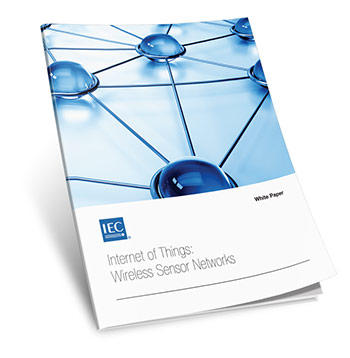
A new white paper by an international team surveys the role of wireless sensor networks in the evolution of the Internet of Things (IoT). The report catalogs current needs for underlying standards and infrastructure that must be met before wireless devices can become, as some envision, nearly as plentiful as dust.
Published by the International Electrotechnical Commission (IEC), Internet of Things: Wireless Sensor Networks was prepared by a team led by Shu Yinbiao, of the State Grid Corporation of China, and Kang Lee, an engineer at the National Institute of Standards and Technology (NIST).
Wireless sensor networks have been called a digital skin. They are self-organizing networks of distributed devices—or nodes—that work cooperatively to gather and transmit information from the surrounding environment, be it a factory, electric grid, field-monitoring site, intelligent transportation system, or virtually any other setting. In addition to sensing the environment, these networks also may handle some control functions, such as adjusting building thermostats, redirecting traffic flows in a city, or optimizing manufacturing processes in a factory.
The IoT is a broader technological concept that embodies wireless sensor networks. As envisioned, the IoT would embed miniature computers in all manner of objects, from the most sophisticated, such as aircraft, to the mundane, such as clothing and appliances. Each object would be uniquely identifiable and linked through an Internet-like structure.
Cisco Systems estimates that the numbers of devices connected to the Internet will double to 50 billion by 2020.
The new IEC white paper discusses evolution of wireless sensor networks within the wider context of the IoT, describes the characteristics of wireless sensor networks and current applications and trends, and surveys future applications and the obstacles that stand in the way. It also assesses needs for standards to achieve interoperability among wireless sensor networks from different vendors and across varied applications.
Given the growing number of uses of wireless sensor networks, it's not surprising that many different standards organizations address various aspects of the technology, often in isolation. The white paper calls on standards organizations to improve communication and coordination, make unified plans, optimize resource allocation, and reduce duplicative efforts.
It also recommends increasing research devoted to improving network performance and quality of service, developing a systems architecture and integration technologies to accommodate diverse networks, developing a common model for ensuring security, and improving access technologies to conserve wireless spectrum and to support larger networks.
"We hope this paper will be a useful resource for a large and diverse community of stakeholders," says Lee. "It provides a much-needed, high-level perspective on the technology's vast potential and on the standards-related tasks that must be accomplished so that we can realize it."
International Electrotechnical Commission, Internet of Things: Wireless Sensor Networks, 2015. Download at: http://www.iec.ch/whitepaper/internetofthings/

